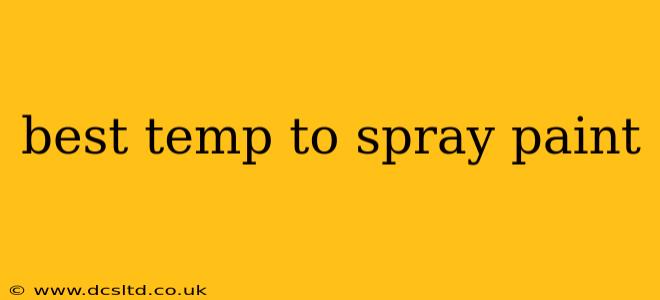Spray painting can transform any project, from a quick touch-up to a major artistic endeavor. However, temperature plays a crucial role in achieving a smooth, even finish. Getting it right can mean the difference between a professional-looking result and a sticky, uneven mess. This guide will delve into the ideal temperatures for spray painting and address common concerns.
What is the Ideal Temperature for Spray Painting?
The ideal temperature range for spray painting is generally between 60°F and 80°F (15°C and 27°C). Within this range, the paint atomizes properly, dries at an optimal rate, and minimizes the risk of issues like runs, drips, or uneven coverage. Temperatures outside this range can significantly impact the outcome.
What Happens if it's Too Cold When Spray Painting?
H2: What happens if it's too cold when spray painting?
When temperatures drop below the ideal range, several problems can occur:
- Poor Atomization: The paint may not atomize properly, resulting in a rough, uneven finish with a grainy texture. This is because the thinner components in the paint may not evaporate as quickly, leading to larger droplets.
- Slow Drying Time: Lower temperatures slow down the drying process, increasing the risk of dust or debris settling on the wet paint. This can lead to imperfections in the final finish.
- Increased Viscosity: The paint can become thicker and more viscous in cold temperatures, making it harder to spray evenly and potentially clogging the spray nozzle.
What Happens if it's Too Hot When Spray Painting?
H2: What happens if it's too hot when spray painting?
Conversely, excessively high temperatures can also lead to problems:
- Rapid Evaporation: The paint may evaporate too quickly, resulting in a dry spray and uneven coverage. This can create a blotchy or stippled effect.
- Runs and Drips: The fast evaporation can cause the paint to run or drip before it fully adheres to the surface.
- Solvent Release: Higher temperatures can accelerate the release of solvents from the paint, potentially causing the paint to crack or peel over time.
What is the best humidity for spray painting?
H2: What is the best humidity for spray painting?
Humidity also plays a significant role. Ideal humidity levels are typically between 40% and 70%. High humidity can slow down drying and potentially lead to a sticky finish. Low humidity, on the other hand, can cause the paint to dry too quickly, leading to issues mentioned earlier.
How to Adjust for Less-Than-Ideal Temperatures?
H2: How can I adjust for less-than-ideal temperatures when spray painting?
While aiming for the ideal temperature range is best, there are ways to mitigate the effects of less-than-ideal conditions:
- Warm the Paint: If it's cold, let the paint cans sit in a warm room for a few hours before spraying. This will help to reduce its viscosity and improve atomization.
- Use a Paint Heater: For larger projects or consistently cold conditions, consider using a paint heater to maintain a consistent temperature.
- Work in a Shaded Area: On hot days, work in a shaded area to prevent the paint from drying too quickly.
- Thin the Paint (Cautiously): In some cases, slightly thinning the paint with the appropriate thinner (always check the manufacturer's instructions) might help improve atomization in cold conditions. However, over-thinning can lead to a weak and less durable finish.
- Multiple Light Coats: Applying multiple thin coats rather than one heavy coat helps to prevent runs and drips, especially in warmer conditions.
Can I spray paint in the cold?
H2: Can I spray paint in the cold?
Spray painting in cold temperatures is possible, but the results might not be ideal. Take the necessary precautions to mitigate the negative effects, such as warming the paint, using multiple thin coats, and working in a protected environment. Always consult the manufacturer's instructions on the paint can for specific temperature recommendations.
By understanding the impact of temperature on spray painting and taking appropriate measures, you can achieve professional-looking results, regardless of the weather. Remember to always prioritize safety and follow manufacturer guidelines for the best possible outcome.
